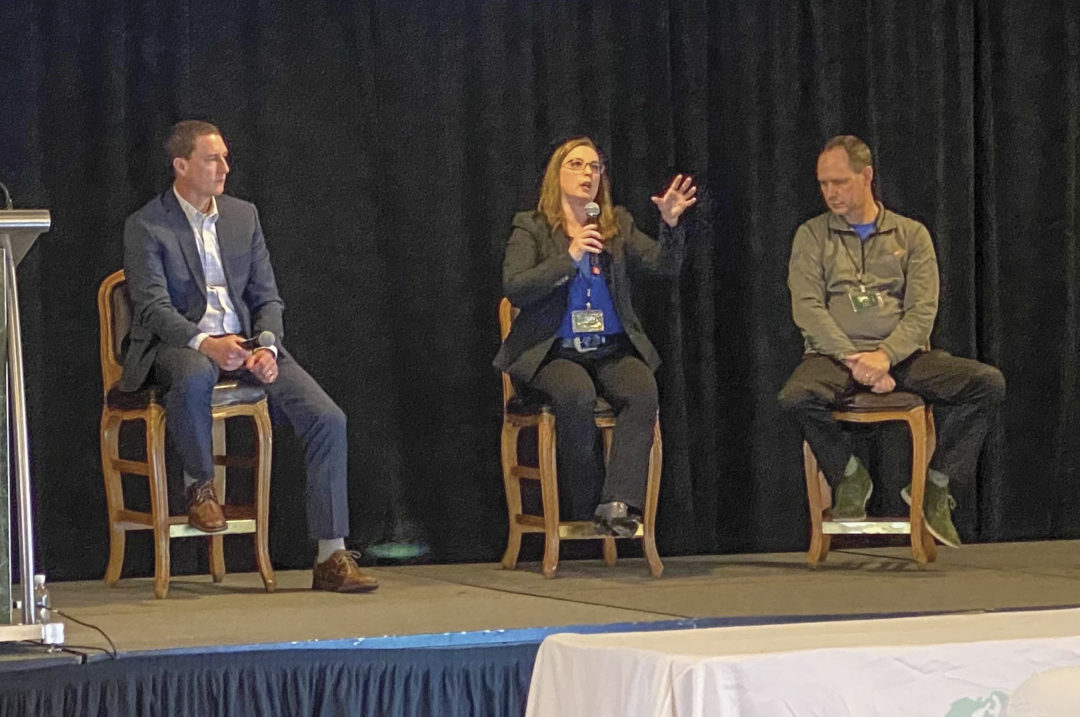The Global Dairy Experience was back in Las Vegas, Nevada, Dec. 5-7, 2023 for thought-provoking presentations, discussions and networking opportunities – giving plenty of opportunity for attendees to draw on the theme of the conference: "Every connection counts."
Jim Mattox, CEO of Cowsultants, opened the conference drawing attention to a study done at the University of Chicago that has found dairy, lamb and beef products could potentially fight cancer. Published in Nature late November, the study found that trans-vaccenic acid – a long-chain fatty acid found in ruminants – could aid in infiltrating tumors and cancer cells. Mattox acknowledged people in the dairy industry who’ve been affected by cancer and praised those in the room working in the industry. “An industry that can fight cancer,” he said.
Mastitis
Following an opening prayer from Adam Zeltwanger of Riverview LLP, Justine Britten of Udder Health Systems presented ideas on managing mastitis in large herds.
“Somatic cell count [SCC] is a lagging indicator,” Britten reminded attendees. “By the time SCC increases, you’re already behind.”
With a dive into the warning signs and detrimental effects of mycoplasma and Staphylococcus aureus, Britten informed attendees of the many dangers that could be lurking in various parts of a dairy. She referenced five pillars of control – teat dipping, backflush, dry treating, identify, segregate or sell, and zero tolerance – when it comes to battling mastitis and asked the audience to consider how these pillars are managed today.
Britten emphasized the importance of hospital pen care when it comes to treating cows with mycoplasma, as an infected mycoplasma cow can easily contaminate other animals in the pen and amplify a problem. She also pointed out that the most common pathogen she is seeing with her clients is S. aureus, although this pathogen is not necessarily a new one to the industry.
Beef-on-dairy
Many voices from both the dairy and beef industries were heard during a beef-on-dairy panel and additional presentations throughout the conference.
Ian Wheal, Mike De Groot, Adam Zeltwanger, Ryan Meyer and Alex Abatti joined one another for an interesting panel discussion tackling different perspectives when it comes to the production of beef-on-dairy animals.

(From left to right) Moderator Ian Wheal asks Mike De Groot, Alex Abatti, Adam Zeltwanger and Ryan Meyer for their thoughts on the current state of the beef-on-dairy industry. Photo by Matti McBride.
“If we stop talking about meat and start talking about milk for a second, one could argue that the workforce in the dairy industry isn’t as good as it used to be,” De Groot, founder of TD Beef, said. “Feed availability and quality has also gone down, but why are cows continuing to produce more milk? It’s because of genetic selection. Now we’re in a position to do something similar on the beef side. I don’t know what the upper limits of this look like, but if we understand how milk has continued to increase year over year, we’re going to see meat and meat quality increase year over year and stronger selection from genetics.”
Zeltwanger noted that looking forward, the Minnesota-based Riverview LLP is placing more emphasis on health traits in beef-on-dairy animals and will be monitoring feed efficiency with a new expansion and facility in Nebraska.
Abatti manages a feedlot operation in Imperial Valley, California, and discussed the dynamic changes that the beef industry could see within the coming years. He likened changes within the fruit and brewing industries to what could potentially happen with beef – consumer preference and interest in production will continue to influence demand.
Meyer, senior vice president of procurement and marketing at Creekstone Farms, reminded listeners of the importance of quality when it comes to creating a beef product.
“With our company, we try and promote the integrity of the product we’re producing,” Meyer said. “Now with access to information instantly, a consumer can find out whether it’s a real product or a marketing scheme. We’re trying to make sure going forward that we tell our story genuinely and let the product speak for itself.”
Matthew Cleveland of ABS Global and Nick Hammet of Neogen presented work being done within the two respective companies to enhance the quality of genetics and resources when it comes to producing beef-on-dairy animals.
Cybersecurity
“My goal today is to get you to leave here with trust issues,” Nathan Maxwell of Communication Concepts said while opening his presentation. “You might not think you need cybersecurity now, but give it 24-36 months and you might want to reevaluate.”
With a discussion about the dangers and potential disasters that can occur online, Maxwell explained how and why dairy producers should be on the offense when it comes to cybersecurity. Hackers prey on large data systems, and the information that keeps your dairy running could be a target. Maxwell provided an example of a friend who was purchasing a home and was baited into giving up his bank account information by a spam email, and all the cash he had saved for that home was gone in an instant. He paralleled this example to a farm manager who might be fooled into giving up password information for a software program to an unreliable source and noted that it doesn’t take much for a cybercriminal to have access to your data.
“How long can you afford to have your robot or rotary down?” Maxwell asked producers in the audience. He encouraged listeners to use both multifactor authentication and long passwords when creating accounts with sensitive data. “We don’t wear seatbelts out of convenience; we do it out of necessity,” Maxwell reminded attendees.
A banker's perspective
Three bankers took the stage to discuss trends they are seeing with dairy producers. Jennifer Peal of BMO, Kurt Petik of Rabobank and Brian Larsen of American Ag Credit answered questions from the audience and gave some interesting insight on the current state of the dairy industry. The discussion touched on farm public relations but primarily focused on farm diversification.
They encouraged producers to find ways to diversify and agreed that non-milk revenue on any operation adds value to each animal on site but cautioned that not every option is a fit for every producer.
The panel also agreed that dairies that try to outgrow problems – usually management-related – generally fail, and they advised producers to fix problems before expanding operations.
Insights on technology
“Technologies are not solutions for bad management,” Holstein USA Analytics and Innovation Scientist Jeffrey Bewley shared with attendees on the last day of the conference.
Bewley presented his thoughts on technology use in the dairy industry based on observations made at the University of Kentucky SmartHolstein Lab, where he tests out new technologies on a small herd. He encouraged producers to ask technology companies tough questions before investing in them and cautioned against adopting too many technologies at once.
Bewley encouraged producers to be proactive in using technology but to “never lose sight of the cow.”









